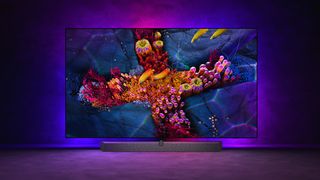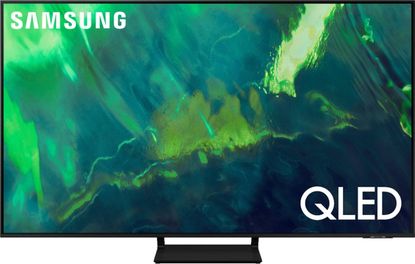QLED is a word you'll see used a lot when you're researching the best TVs, but it sort-of means nothing all on its own (well, it's loosely Quantum Dot Light Emitting Diode, if you love an almost acronym).
As a word, QLED also reads a lot like OLED, but you don't want to get the two panel types confused, as we'll come to later. There are pros and cons for each, but right now we're going to focus proper on QLED.
QLED TV: What is a quantum dot?

In short: a QLED TV is actually an LCD panel (that's Liquid Crystal Display, again for the acronym lovers). It's just there's an LED backlight behind it – three key letters from 'QLED'.
The 'Q' part? That's Quantum Dot. While 'normal' LED TVs use a coloured LCD filter layer on top of the LED backlight, a Quantum Dot's backlight is converted to pure colours by a different film before it reaches the LCD colour filter, helping the colours stay more accurate and bold. That's why QLED is so colour-rich and saturated.
That Q is not just marketing bluster though: Quantum Dots are a practical example of nanotechnology. In this case they're tiny fluorescent particles, synthesised in a lab, which measure between two to 10 nanometers in diameter, i.e. they're tiny.
While quantum dots have a number of bafflingly complex practical scientific applications, we're concerned here with light. When a quantum dot absorbs light, its chemistry essentially converts to light of a particular and very specific wavelength. The size of the particle determines the colour it outputs: larger dots release energy at a slower rate, giving them a wavelength close to red, while smaller dots trend towards blue.
Want to see Samsung's latest? Here's the company's QLED TV page on its official site so you can browse its QLED range.
What about Neo QLED?

Technology evolves, of course, and Samsung has elevated QLED with its next step: Neo QLED. This, ultimately, is combining Quantum Dot's benefits with Mini LED backlighting, meaning there are more, even smaller LEDs for illumination. This enhances backlight precision.
But as there can be more Mini LEDs used in the backlight, Neo QLED has the capacity to be even brighter than QLED. It's this added brightness output, which is expressed in 'nits' that gives a more striking image, without foregoing the control at black and near-black levels.
Obviously Neo QLED offers more, but that's also why it costs more and, for now, is the reserve of Samsung's upper spectrum of TVs. It began life in 2021, so isn't a particularly old technology.
QLED vs OLED: How does it compare?

QLED’s major rival in high-end TV tech is OLED, the latter which uses self-emissive pixels that don't need a backlight as they illuminate themselves, giving these TVs incredible control over the panel. Each pixel can dim itself right down to being off for when dark or black content needs to be shown, and this can be right next to a pixel blaring at full brightness, meaning dazzling contrast between the two. However, these individual pixels can't go that bright compared to a large backlight, such as QLED or Neo QLED. LG, which produces the OLED panels, has introduced 'EX' versions in 2022 that can be brighter than their predecessors, however, narrowing the gap between the two tech types.
QLED gets its light from a bright cluster of white or blue LEDs, shone through a complex diffuser to ensure complete coverage of the screen – more light means more brightness. However, having this broad light means it's hard to have very dark and very light areas next to each other, because they have the same light behind them. High-end QLED TVs therefore have backlights that can be dimmed in zones, so that dark areas can be truly dark and light areas nearby can have all the brightness they need. Samsung has developed ways to deflect light rays to avoid light bleed, too, with very effective results.
QLED TVs: The pros and cons

QLED's similarity to existing tech means that companies have been able to scale it up very quickly, both in terms of size and resolution. You'll find really large screens in the QLED domain, and there's a lot more room for experimentation.
QLED also trends towards the cheaper end of the market, with brands like TCL and Hisense banding together with Samsung to create low-cost screens, and the larger panels tending to compete strongly with OLED in the wallet department by at least a small margin.
Then there's the picture. QLED is frankly a stunning experience if you're not used to high-end displays, with incredible colour reproduction, vast contrast, and high amounts of saturation, the perfect medium for HDR content.
Quantum Dots are inorganic, meaning QLEDs should suffer far less picture degradation over time compared to similar OLED panels. LCD is a durable tech –we're not far enough along the QLED track to conclusively prove its longevity, but it's likely to stay in tip-top condition longer than OLED.
QLED massively improves the contrast of standard LCD displays, but it's not absolutely perfect. Zoned illumination helps to darken areas that need to be darker, and there's a lot less of the greyness that non-QLED screens display, but QLEDs do suffer from light bleed, where a slight haze surrounds bright objects in an otherwise dark scene, and there's not as much nuance visible in dark scenes as OLED.
While viewing angles have been steadily improving over time, QLED screens do tend to look best when viewed head-on – this does depend on the LCD type used, but it's pretty much a universal constant that the further you go from central, the worse the picture will look, though a lot of work is done in high-end screens to mitigate this.
QLED is also a little slower than OLED. There's still a liquid crystal panel in there, and that requires a little extra time to turn on and off, unlike the instantly addressable pixels of an OLED panel. This tends to be more of a theoretical problem, though – you don't see any real effect of this on the best TVs.



